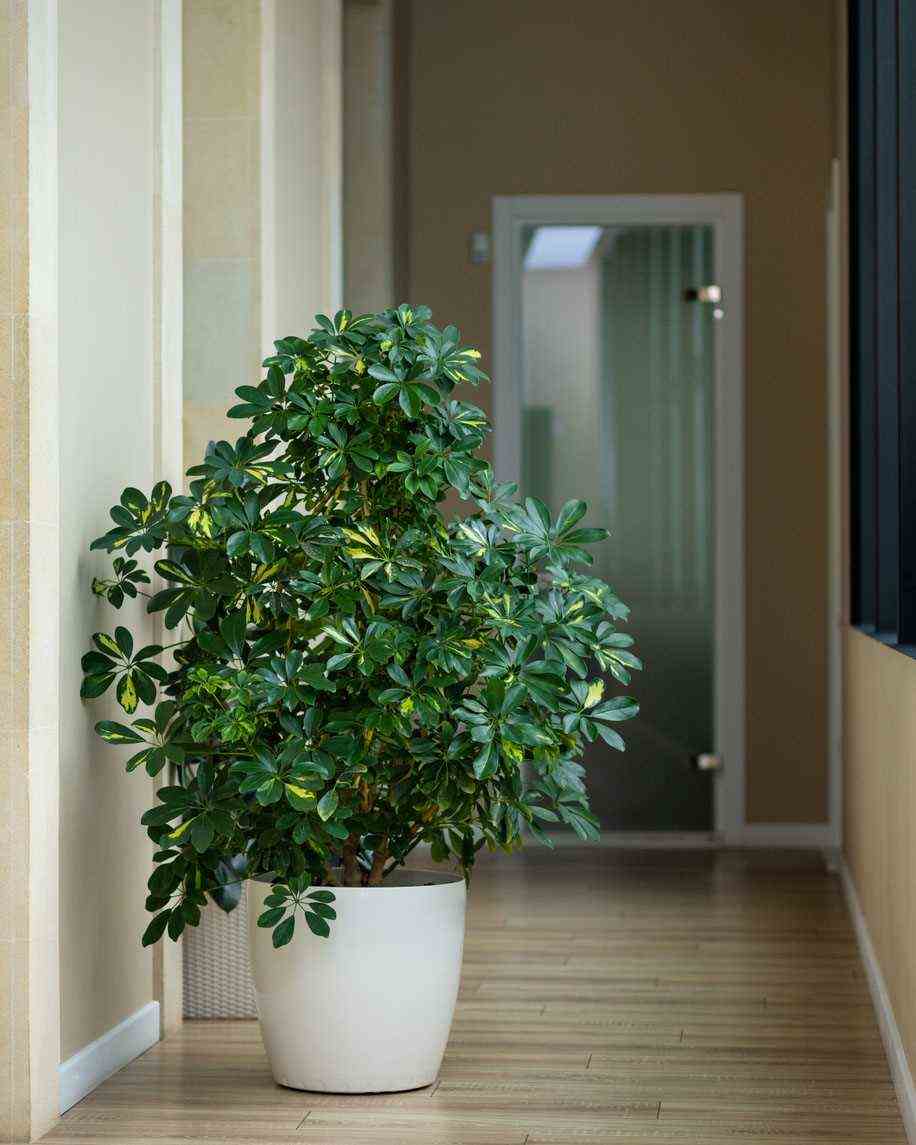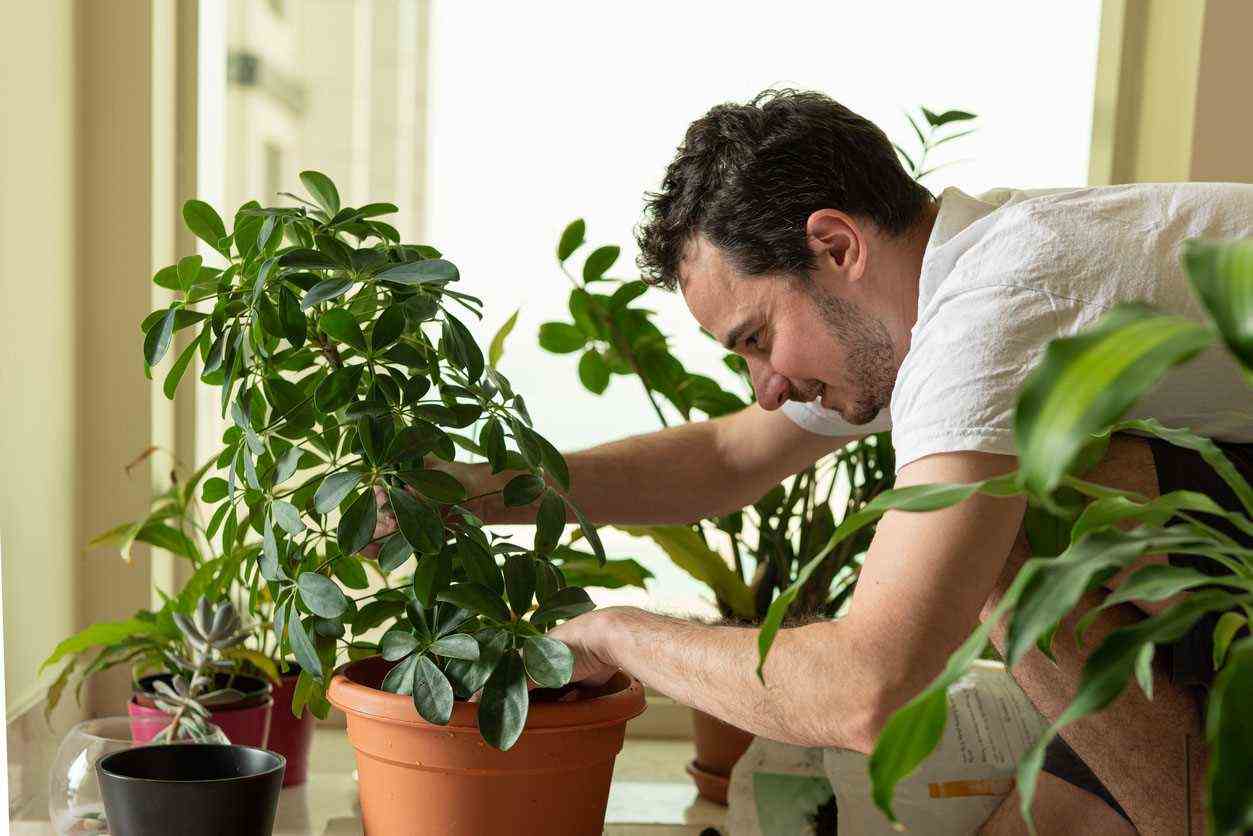Presentation of Schefflera
Fact sheet : | |
|---|---|
| Scientific name | Schefflera arboricola |
| Family | Araliaceae |
| Other name | Parasol, Umbel tree, Umbrella tree |
| Ethymology | The genus name of these plants is a tribute to JC Scheffler, 18th century Danish botanist and friend of the great Linnaeus. |
| Origin | Australia, Asia, Central America |
| Dimensions | At home, in a large container, it can exceed 1.80 m, but it does not flower. From 30 to 60 cm in bonsai. |
| Flower color (s) | Dark greenYellows |
| Leaf color (s) | Dark green |
| Appearance of flowers | They are rare, small, green and unattractive. |
| Appearance of leaves | Its leaves are large, bright green, divided into several oblong leaflets (usually three to seven) of about 30 cm, but in a healthy adult, up to sixteen may be counted. The leaves unfold at the end of a very long stem, like the rays of a parasol. |
| Type of plant | Tree |
| Vegetation | Perennial |
| Foliage in winter | Persistent |
| Flowering |
Culture sheet: | |
|---|---|
| Planting |
Jan.
Feb.
Mar.
Apr.
May
June
Jul.
August
Seven.
Oct.
Nov.
Dec. |
| Exposure |
Protected from cold winds, Bright light |
| Ground | Good soil, Soil, Peat, Sandy |
| Humidity | Low |
| use | Pot, Tray |
| Multiplication | Semi, Cutting, Layering |
| Disease (s) and pest (s) | Aphids, Mealybugs, Spider mite, Leaf spots, Mites, Root rot |
Description | Vigorous shrub, up to 2 m tall in pots, cultivated for its decorative foliage. The leaves are palmate, compound, formed of several elongated, leathery oval leaflets. The number of leaflets can vary from three to five in the young leaves and reach numbers from seven to fifteen in the adult leaves. They are shiny green above, lighter on the underside. Plants grown indoors usually do not flower. Like the Benjamina ficus, the schefflera is native to Australia where it grows to a 40 m tree which, in spring, is covered with scarlet flowers. |
|---|
Exposure and humidity
Provide the plant with bright light, but keep it away from direct sunlight. Shade is well tolerated.
He needs a moderate humidity. Spray the foliage when the ambient temperature exceeds 18 ° C. Insist on the underside. Don’t forget the fertilizer.
Ideal temperature
In summer, temperatures in mild climates are suitable for the plant. It should ideally be between 16 and 18 ° C, but the plant tolerates more heat if the air is humid enough. Below 13 ° C, it can lose its leaflets.

In winter, do not let the temperature of the room fall below 10 ° c, but also do not raise it above 16 ° c, otherwise, instead of going to rest, the plant will continue to grow, s ‘will weaken and attract mealybugs.
Watering the Schefflera
During the growth period, give enough water so that the mixture be very wet, but let two-thirds dry between waterings, on average twice a week.
During rest period, water just enough to avoid complete drying out (drought reduces the size of the leaves and causes them to turn yellow), on average once a week.
Soil and fertilizer
Choose a mixture by thirds of organic potting soil, 1 peat and 1 sand.

Give a contribution ordinary liquid fertilizer (or a pinch of organic fertilizer powder) every 15 days during the growing season (in April and May). In June, September, October and January, halve the amount of fertilizer.
Repotting the Schefflera
Repot in early spring if you deem it necessary (generally every 2 years). When the plant has reached optimal size, renew the top layer of the mixture once a year. Support the main rod.
for a guaranteed visual and aesthetic effect, repot in a rather large, flat ceramic in shades of blue or celadon green.
Multiplication

It is carried out by sowing fresh seeds at the end of winter, or by leaf cuttings, trimmed and placed at 18-21 oc. Provide gentle background heat to promote germination. Multiplication can also be done by layering or by head cuttings.
After rooting (about 1 month), gradually acclimatize the plant to the final ambient conditions.
Cut
The young schefflera presents difficulties to branch out. It should be pinched regularly. Cut just above a beautiful leaf to allow the plant to emit new shoots.
Species and varieties
There are 900 species. Schefflera arboricola (or Heptapleurum) and Schefflera actinophylla (or Brassaia) of very similar appearance make very beautiful bonsai.
The 6 points to remember about the culture of Schefflera
- Plant easy to grow indoors.
- Likes bright light, but not direct sunlight.
- The ideal growing temperature is 16-18 ° C all year round, but can be higher if there is sufficient humidity.
- Does not support drafts.
- Water sparingly, allowing the soil surface to dry out between waterings.
- From March to October, administer liquid fertilizer every 2 weeks.

